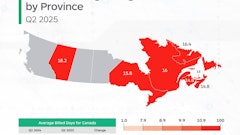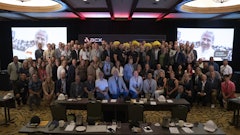
Story by BY RICK FIFER, ACOAT SELECTED BUSINESS SERVICES, AKZONOBEL
Most collision repairers will list word-of-mouth as a core component of their marketing strategy. But how can word-of-mouth be part of a strategy? It’s incredibly difficult to measure and all but impossible to manage! Relying on word-of-mouth as part of a marketing strategy is like saying you hope your customers are happy, and you hope they tell their friends, and you hope their friends come to you when they need collision repair services. Hope is not a strategy.

AN EXHUMATION
The Merriam-Webster dictionary definition of word-of-mouth is “orally communicated” or “generated from or reliant on oral publicity”. Varying studies over several decades agreed that people were likely to tell a handful of friends about a positive consumer experience but were likely to tell even more friends about a negative experience. Furthermore, they were likely to continue to tell the negative story further into the future than the positive story.
AN EVOLVEMENT
As you may have already surmised, the internet and online reviews are the real cause of word-of-mouth’s death. Ok, maybe that’s an exaggeration. Word-of-mouth didn’t die; it evolved into word-of-web!
Word-of-web isn’t limited to just friends and family. Rather than just telling a handful of people over the course of a week or two, word-of-web potentially tells thousands of people. Maybe more! Forever!
According to Podium, 93 percent of consumers say online reviews impact their purchase decisions, with 58 percent looking at online reviews at least weekly.
INTERNET HIDE & SEEK
Once again, per Podium, 54 percent of consumers find a local business with a generic web search, such as “bodyshop near me”, with another 30 percent searching in Apple Maps or Google Maps. Combined, that’s 84 percent that find a business with some form of internet search.
By default, most Android devices use Google Chrome and Google’s search engine. Apple doesn’t have its own search engine so users can select their preferred search engine when using Apple’s Safari browser, but it’s important to note that Google is Apple’s default search engine. Because of this, most consumers immediately see Google ratings in their search results. On the other hand, Apple Maps is connected to Yelp reviews and ratings, while Google Maps is obviously connected to Google reviews and ratings.
That’s 84 percent of people that see ratings, and potentially reviews of some sort, before they see your website! In fact, just 13 percent go directly to a business website and bypass the generic web search.
CULTIVATE YOUR ONLINE REPUTATION
Your online reputation is like a garden. You can’t just throw some seeds in the yard in the spring and expect to have a bountiful harvest in the fall.
It’s human nature for people to speak out publicly when they’ve experienced extremely poor or exemplary service. These extreme ends of the spectrum produce ratings of 1s and 5s. The equivalence of weeds and flowers!
Another statistic says that consumers typically will not consider engaging with a business that has less than a 3.3-star rating, so those fours are extremely important!
• Prepare the soil Reinforce the importance of good ratings and reviews with your team. After all, they are the ones responsible for your customers’ experiences. They are the gardeners! Decide which review sites you want to cultivate. This can change as your garden grows. You might receive many good reviews on one platform but not another, which can shift your focus.
• Plant the seeds Yet another Podium statistic finds that 77% of consumers say they would be willing to leave a review if asked. Better yet, at the beginning of the process you can ask the customer what it will take to earn a 5-star review. Then at the end of the process you can review those expectations to ensure they were met, almost obligating the customer to provide that 5-star review!
• Water your garden It’s good practice to acknowledge and reply to ALL reviews. A simple thank you comment on positive reviews can suffice, but how you handle the negative reviews can make a big difference. Your replies are more for the people that might be considering doing business with you, than for the ones that already did business with you!
• Weed your garden You can’t pluck one- and two-star ratings and reviews and just toss them in the compost pile like you can with weeds. Ratings and reviews live forever, but they don’t all remain in the spotlight, or sunshine, to maintain our garden analogy.
Your online reputation is like a garden. You can’t just throw some seeds in the yard
in the spring and expect to have a bountiful harvest in the fall.

FAST TIPS: GETTING GREAT REVIEWS
1. Replying to a negative review with an offer to rectify a customer concern can sometimes result in a negative review being changed to a positive review!
2. Actively seeking reviews can increase your four- and five-star ratings, which will minimize the impact of occasional negative reviews.
3. Negative reviews eventually drop off the radar. They’re still there, and still impacting the overall average, but are no longer front and center. Most consumers will just read the most current reviews, not wanting to scroll through multiple pages. Choke out the weeds with flowers!
REAP WHAT YOU SOW
While your marketing strategy likely includes community outreach, traditional advertising, promotions, and third-party referrals, it should not include word-ofmouth. Word-of-web is how consumers determine where they will receive the best overall experience!
Regardless of how they first learn of you, they are still going to check your online reputation. And if your online reputation meets their expectations, then they’ll visit your online homebase – your website.
Cultivate your online reputation and don’t leave a significant part of your marketing strategy to chance. Ensure your website is easy to navigate and quickly provides the information consumers need.
Finally, after all that work, you get to enjoy your harvest – more reviews and higher ratings, which will drive more work to your door!


HOME SECURITY
Let’s not discount the value of your website. Most consumers will visit a website once the business has passed the review test. Your website is your internet homebase. It’s the ONLY place online that you have 100 percent control of your message.
When was the last time you audited your own website and tried to look at it as though you were seeing it for the first time as a potential customer? Is it easy to navigate? Is it visually appealing?
The following 10 items are found on many collision repairer websites. Here’s how we ordered the importance of these items.
1. OE and other certifications—potential customers want to know if you are qualified to repair their car. OE and other certifications, such as I-CAR, should be prominently displayed. Don’t make the user hunt for them!
2. Contact information—once they’ve decided your shop is qualified to repair their car, they’ll want to know how to contact you. It should be prominently displayed on the top of the page.
3. Appointment scheduler—we live in a world where appointments of all types can be scheduled online. It’s expected that you will offer this convenience as well.
4. Photo estimating—you and I understand the inaccuracies of photo estimating, but your potential customers don’t. If they see this offered on a competitor’s website and not yours, it might be the reason you lose the job. A connection via a photo estimating tool allows you to schedule a more thorough inperson evaluation and do some old-fashioned selling!
5. Ratings and reviews—despite the importance of ratings and reviews, we ranked it #5 because they’re already on your internet homebase, which means they likely found you via a generic web search and already saw your ratings and maybe read some reviews. Providing the ability to see your Google, Yelp and other ratings and reviews directly on your website demonstrates your commitment to providing the best customer experience.
6. Contact us form—if you have one on your website, ensure it’s monitored frequently.
There’s nothing more frustrating to a potential customer than completing a Contact Us form and then receiving a reply days later. Or worse, not at all!
We’re not that particular about the order of the rest of the items but included them since we see them included on many shop websites.
7. Additional services provided—This is your first opportunity to upsell additional services.
8. Photos of the team members—A “meet the team” section adds a personal touch but also must be kept current.
9. Before and after pictures—These add little value. The worst repairers can make the outside of a car look good, but will the ADAS features function properly in the next crash? Will the welds hold? OE certifications are far more important than before and after photos!
10. List of your state-of-the-art equipment —Your customers have no clue what any of this stuff is, but some might be impressed that you took the time to list it for them.


















